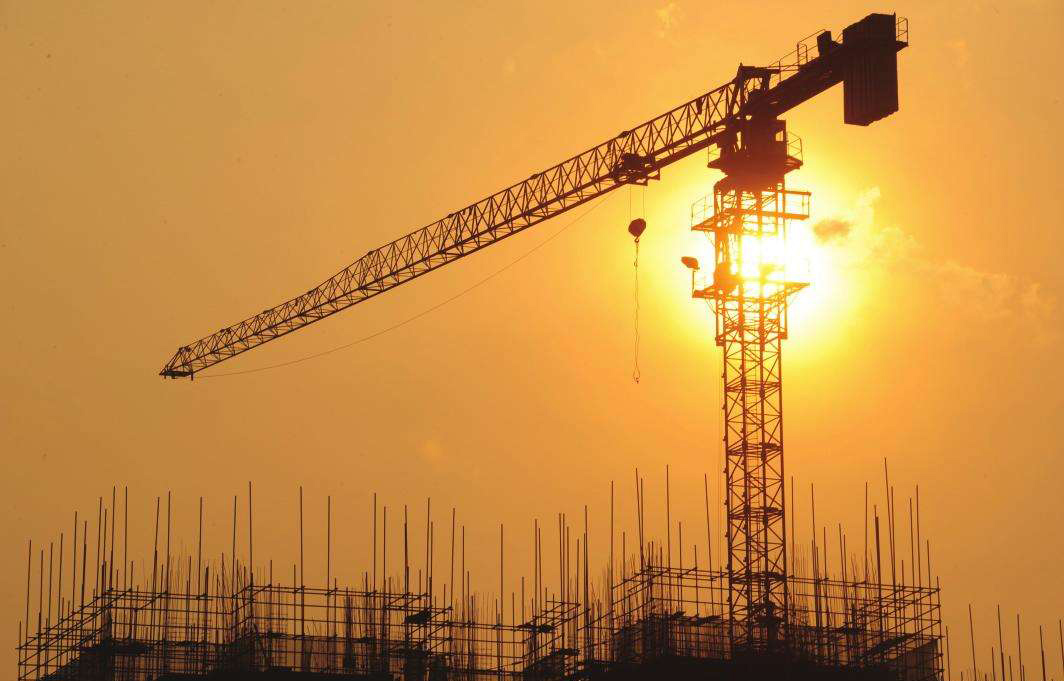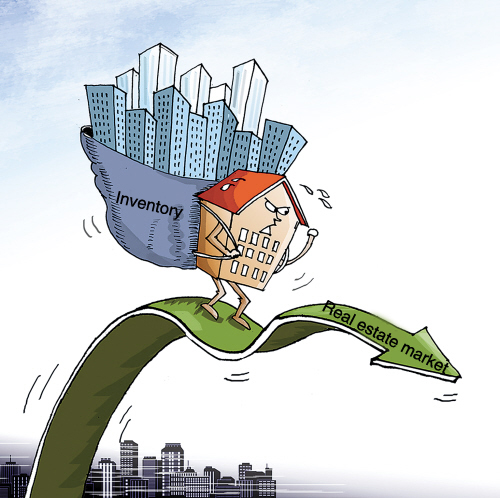Domestic cooling property market to stabilize in 2015

The Chinese property sector will continue to limp along in 2015, presenting the urgent need to strike a balance between economic restructuring and growth stablizing.

The oversupply of new houses has made China’s real estate market unstable.
China has entered a key phase of comprehensively deepening reform in 2015. The macroeconomic downturn has continued to intensify pressure and various risks are likely to heighten or spread, highlighting the need to strike a balance between economic restructuring and growth stabilizing to stay on track for targeted GDP growth of seven percent.
As an important component of China’s macro economy, society and people’s livelihoods, the real estate market is also facing a downward trend. Its formidable tasks include downsizing supply, deflating the bubble, controlling risks and preventing a crash.
The central decision-making body is facing a serious issue of how to ensure proactive adjustment and healthy development of the property market through timely strategic adjustment, opportune institutional innovation and proper policy implementation, thereby promoting the smooth achievement of macroeconomic goals.
Weak fundamentals
The property market adjustment, which was started in early 2014, features the overlap of the long-, medium- and short-term cycles. This prolongs and deepens the adjustment, and signals remarkable changes to the future and expectations of the adjusted real estate sector.
The pessimistic outlook will cause home prices and sales to fall. Since there has been no lack of housing, the real estate registration regulation has taken effect and anti-graft efforts have been beefed up, cautious and pessimistic outlooks will linger in China’s property market in 2015, exerting negative impacts on property investments.
The positive effect of monetary policy on housing prices and sales will be reduced. Under moderately prudent monetary policy, financial authorities will provide loose window guidance for financial institutions to formulate credit policies. However, in view of the broad picture, financial institutions will remain cautious in capital supply and discounts for home loans will be limited. Property developers will also lose their power to raise prices.
First, there is an oversupply of new homes. In terms of commercial housing, the ratio of the floor space under construction to area sold has climbed from 2.9 in 2001 to 4.2 in 2014. It will take more than 15 months for nearly 35 large and medium-sized cities to run down stocks. Worse still, the inventory cycle for low-tier cities will be longer.
Second, a vast number of houses remain empty. In 2013, the urban per-capita housing area exceeded 33 square meters. Homeowners who owned more than two homes accounted for 21 percent of the total. The secondhand housing market will see supply soaring.
Third, most real estate enterprises are financially stressed. Small and medium-sized companies, in particular, will not benefit from monetary policy adjustment, and continue to risk financial ruin. As financial conditions have a huge bearing on housing price fluctuations, most property developers are expected to lower prices to boost sales.
Demand for housing is also likely to cool in the long term despite an initial revival. In 2015, the urban marriageable-age population and rural migrant population will stabilize demand for housing. However, slowing economic growth will decelerate income growth. Affordable housing supply and renovation of shantytowns will reduce and divert a fraction of demand.
Due to various expectations, it is uncertain whether rigid demand will emerge earlier or later. In 2015, rigid demand is expected to stay between 800 and 1,000 million square meters.
There is little likelihood that investment and speculation demand will explode. Even if active fiscal and tax policies are effective, middle-income families have been overstretched. In addition to the impact of expectations, demand of investment for improvement purposes will see little growth.
Moreover, the recovery of economy and the housing market in some countries will lure some Chinese to transfer capital and property investment overseas. Financial reform, capital market expansion and recovery of equities will make free money flow to the stock market.
Against the backdrop of market segmentation, there are still investment opportunities in first-, second- and even some third-tier cities, including opportunities presented by the release of investment demand in surrounding areas and the whole country. It can be expected that non-local rigid demand will reach 200 million to 300 million square meters in 2015.
Market stable despite decline
In 2015, there is a strong chance that proactive fiscal policies and moderate currency control will jolt the Chinese property sector.
From the perspective of the supply side, commercial housing prices will rise slightly month-on-month but decline year-on-year. In order to speed up capital turnover or reduce losses to avoid bankruptcy, most developers will continue to lower prices in a bid to boost sales. Compared to 2014, prices will fall moderately in 2015 on the whole.
On the demand side, the commercial property sales volume will show a small increase. Rigid demand will increase year-on-year and nonlocal home-buying demand will rally. Throughout 2015, approximately 100,000 square meters of housing will be sold, up about 3 percent from 2014.
Generally, commercial housing prices and sales will stabilize amid decreases. Intermittent introductions of stimulus policies will send ripples to the property market. Each introduction will give rise to short-lived and slight rebounds.
However, these polices are not panaceas. In the short term, the market will continue its downward spiral. Overall, the real estate market in the first half of 2015 will be jumpy with small drops dominant, and the latter half will be characterized by consolidation and fickleness.
Regional disparities
As to cities, the commercial housing market will exhibit different trends in different cities.
First, real estate in first-tier cities is expected to revive. Because of lower inventories and noticeable adjustments made in 2014, latent demand will be considerable. Month-on-month growth is anticipated in the first half of 2015 and year-on-year growth will be achieved in the latter half.
Second, second- and third-tier cities will be in markedly different situations. In 2015, only a small number of cities will embrace bounces, while most cities will spend more than one year adjusting.
Third, many homes in lower tier cities will be unoccupied due to oversupply and weak demand calls for longer-term adjustments. In 2015, destocking will be the main task to finish as prices and sales will display a continued momentum of decline.
Generally, three different scenarios will take on in lower tier cities. A few cities characterized by big population increases and promising industry development will see rises in both prices and sales. Most medium-sized cities will finish adjustments in 2016 and 2017. In some sparsely populated cities with population outflow, the property market will linger in a weak state or recession.
In terms of risk, a host of problems will be exposed on the real estate front in some regions. Due to structural and regional surpluses, some large real estate enterprises and most medium-sized and small companies will suffer serious fund shortages.
Even if monetary policies are loosened, it is extremely difficult for medium-sized and small real estate companies to improve their financial outlook.
In 2015, many property enterprises will either be merged, reorganized or go bankrupt, resulting in halted construction and half-finished buildings, layoffs of migrant workers, wage arrears and debt default. As medium-sized and small companies mostly finance themselves through private lending, regional financial risks are likely to spread.
A slight change in the real estate industry will gain ground through multiple channels and then generate significant impacts on macroeconomic growth, employment, tax revenues and prices. High importance must therefore be attached to movements in the sector.
Ni Pengfei is director of the City and Competitiveness Research Center at the Chinese Academy of Social Sciences.
